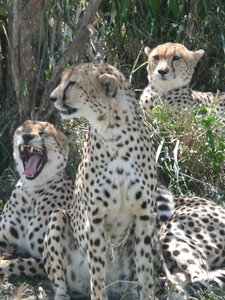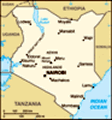Advertisement
Published: April 23rd 2011

 Male cheetahs
Male cheetahs
A thrilling pose from three cheetahs at rest.The predators of the Masai Mara despatch their prey with extreme prejudice. Here in Kenya's world famous national reserve there is no mercy for prey animals, if a predator has even a sniff of an opportunity to kill and eat. This is nature at it's most primal, where humans are privileged to observe wild animals as they engage in a struggle to the death that stretches back to the dawn of man. Kenya plays host to African wildlife that is the envy of the world, and it's less than 200 kilometres west of Nairobi. The added bonus is a more competitive safari price than across the border in Tanzania.
The great African adventure, dear reader, left off in Nairobi, after an excellent spot of downtime with a terrific group of guests at the premium hostel in the city. The word around town is the building will be repossessed by the owners, but if any prospective businessmen want the perfect model for backpacker success I suggest you check out the setup at Milimani Backpackers. Following on from some enquiries around town I was able to join a group for a three day safari to the Masai Mara, and after the wonderful

 Lions in the morning
Lions in the morning
No luck hunting last night.memories of the Serengeti Plains I was excited to see my favourite animals again on the other side of the border. Our team consists of a diverse group of five travellers, under the charge of our outstanding guide George from Big Time Holidays Ltd. We drove for about five hours before arriving at our camp on the edge of the legendary Masai Mara national reserve. A quick refresh and a cuppa followed, and then we set off for our first bit of game spotting, as the weather cooled in the late afternoon. The other members of our team are on their first safari, and it was great to see how thrilled they were to see wild African animals for the first time in their natural environment. The Masai Mara is teeming with animals, and before long I was thrilled to see my first pride of lions on a safari. A large group of fifteen animals were rousing themselves to hunt as we arrived. The trucks followed slowly as the experienced lionesses closed in on a buffalo herd, with the rest of the pride watching the hunt with as much anticipation as the humans. It seems one of the less experienced

 Elephant roaming
Elephant roaming
Early morning in the reserve is so beautiful.hunters broke her cover too early, and the targeted antelope grazing with the buffalo herd escaped. This stirred the buffaloes who then rallied together to rouse away the lionesses, who retreated at a trot right past our truck.
We woke early at Mara Chui camp after a great sleep in a real bed, with the tents attached to a permanent structure that features flush toilets and hot showers. This was my first experience of safari luxury, and it's the way to go in future in order to remain fresh for the next day's game spotting. We had a long second day on safari, which ended up being amongst the most memorable days of my life. The animals were wonderful as you'd expect, but our day in the reserve quickly morphed into something special. Early on in the morning we came across the big lion pride relaxing together, but without a kill. The van was parked a few metres from fifteen magnificent animals. As we pushed on we saw a big male sleeping, and I heard a roar behind the truck. I looked quickly behind to see two lions mating on the hill. That was a great thrill for the

 Cheetahs spot the zebras
Cheetahs spot the zebras
This could be interesting.team, but we soon pushed on and came across three male cheetahs resting, and again George stopped the van only a couple of metres from the animals. I'm thrilled with the photos I took while observing the glorious predators.
However, our cheetahs were still alert to opportunities on the savannah, even while apparently relaxing. They spotted three zebras in the distance and the wind direction was favourable, and suddenly the magnificent animals transformed themselves into ruthless killers with frightening efficiency. We were privileged to witness them stalk the unsuspecting zebras, stopping and crouching in time with the herbivores. We followed in the truck as six animals suddenly burst across the savannah in a stunning display of speed and acceleration. We thought the desperate zebras were clear of their pursuers after a long chase, but one made the fatal mistake of heading towards a shrubbery at the crucial moment. As we drove up we saw two zebras circling around calling to their stricken comrade, and it was clear an animal was down. We stopped a few metres from predator and prey, and witnessed a primal life and death struggle. It's rare for cheetahs to bring down a near mature zebra,

 Masai Mara savannah
Masai Mara savannah
Giraffes and a Thompsons Gazelle strike an unusual pose.and it was over ten minutes before the slowly strangled animal finally stopped struggling and drew it's last breath. We heard later the cheetahs ate their fill without being harassed by other predators or the circling vultures, and come mid afternoon a lion pride finally swept in to finish off the carcass. The hunt was an extraordinary insight into primal nature our safari team will never forget.
We pushed on to a hilltop overlooking the Mara river, after taking a quick toilet stop in an open plain. Our day proved to be an authentic safari experience under George's leadership from start to finish. We were caught up in a heavy shower, so decided to have lunch in the van with the roof pulled down. After lunch we headed down to the river, and watched an extraordinary display by the animals on the plain. The rain made them as frisky as teenagers as the Topi antelope bucked and locked horns, while the zebra nipped at hocks as they chased each other around. We arrived at the Mara river, which is the world famous migration crossing point featured on televisions around the world. In July or August the annual migration of
a million wildebeest and two hundred thousand zebras from the Serengeti Plains occurs, as they search for better grazing to the north. We got out of the truck to observe several hippos in and out of the water while they also watched us warily, and also saw nile crocs in the river. On the way home we saw eleven ostriches walking across the plains in single file, and George says they dutifully follow mum and dad along. The team was well hyped over dinner, and even George seemed galvanised to join in our debrief of the cheetah hunt.
On the third morning we were joined by an American girl for our final game drive. The lion pride was batting none for three, and were lounging around again without a kill to devour. Some of our team members finished the safari with a Masai cultural tour, which I enjoyed previously in Tanzania. We drove back to Nairobi, and arrived late in the afternoon to complete an extraordinary safari in the Masai Mara. I can't resist spending a few more nights here in the safari capital of the world Nairobi. Once again I'm hunkered down amidst great company at my favourite

 Preparing to hunt
Preparing to hunt
The third cheetah just before he joined the zebra hunt.African hostel, basically all of you should be here now!
I see your wild eyes turn soft with our reflection. A certain knowing. Thankyou silently, privately perhaps and go. You have things to do." Ancient Japanese poem
As I continue my travels, until next time it's signing off for now
Tom
Note: Feel free to post comments on this site, or click on the subscribe button for notification of upcoming travel journals
Advertisement
Tot: 0.116s; Tpl: 0.014s; cc: 13; qc: 27; dbt: 0.0674s; 1; m:domysql w:travelblog (10.17.0.13); sld: 1;
; mem: 1.2mb




















Enchanted Landscapes
non-member comment
The Predator now has new prey - humans
The predator in Kenya is increasingly getting marginalised as their habitats are taken over by man and this has created a new phenomenon most aptly described as human-wildlife conflicts. Nature has not also been any friendlier in the recent past and drought has become commonplace. Lions, for instance, rarely hunt humans for food, and will try to avoid confrontation most of the time. However there have been cases in the past when lions hunted humans like the man-eaters of Tsavo mainly (read full story on www.enchanted-landscapes.com/travelogue) because of food scarcity or they were wounded and humans provided an easy target for food. In this regard, the predator has added a new prey in its food chain - man - and it is scary!